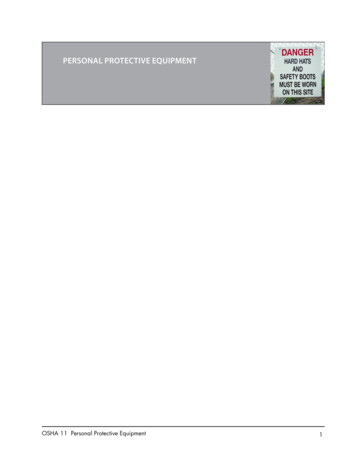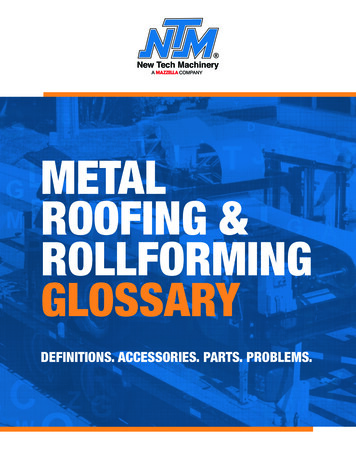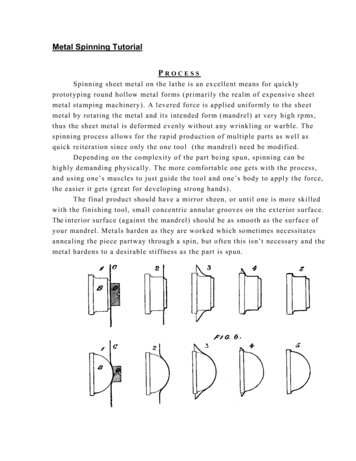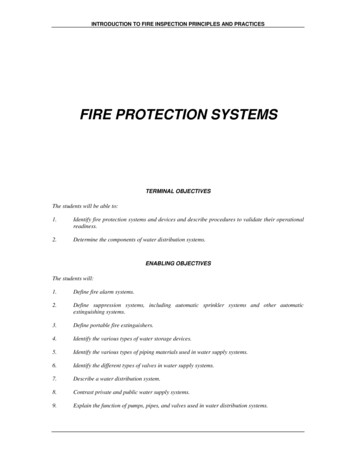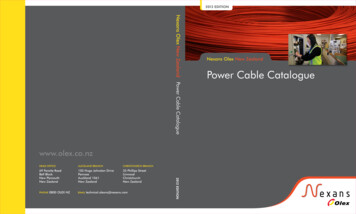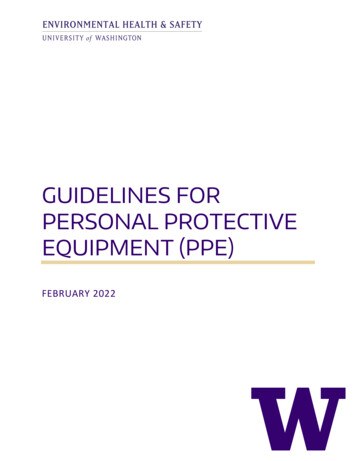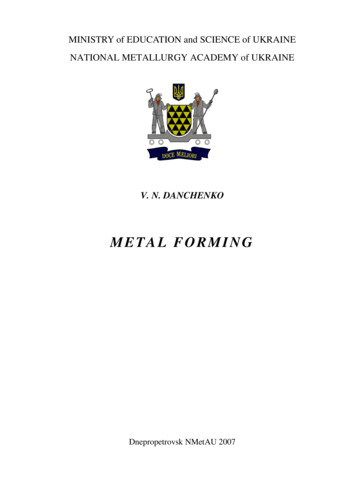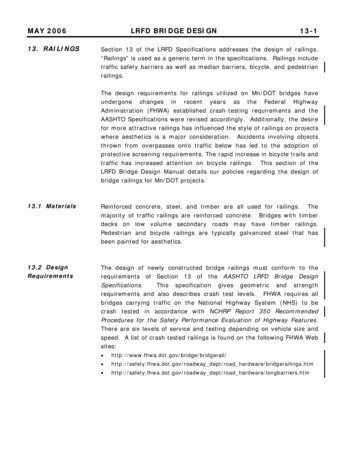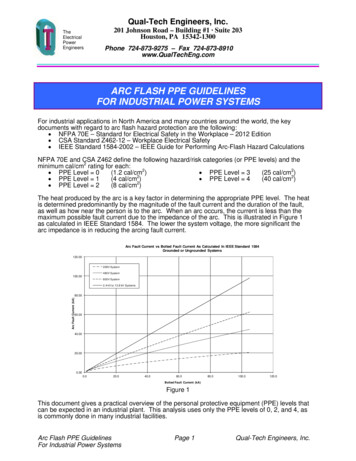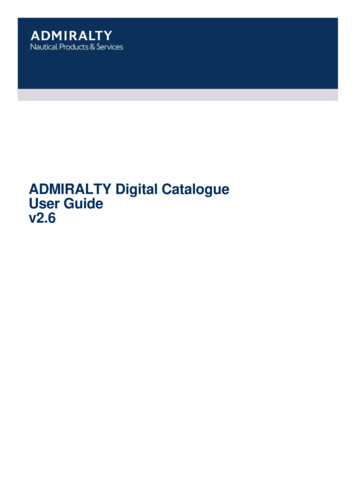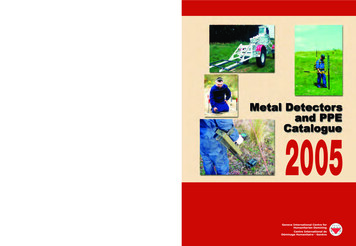
Transcription
Metal Detectors and PPE Catalogue 20052005Geneva International C entre for Humanitarian Demining7bis, avenue de la PaixP.O. Box 1300CH - 1211 Geneva 1SwitzerlandTel. (41 22) 906 16 60, Fax (41 22) 906 16 90www.gichd.ch
iMetal Detectors and PPECatalogue 2005
iiThe Geneva International Centre for Humanitarian Demining (GICHD) supports the effortsof the international community in reducing the impact of mines and unexplodedordnance (UXO). The Centre is active in research, provides operational assistance andsupports the implementation of the Anti-Personnel Mine Ban Convention.For further information please contact:Geneva International Centre for Humanitarian Demining7bis, avenue de la PaixP.O. Box 1300CH-1211 Geneva 1SwitzerlandTel. (41 22) 906 16 78Fax (41 22) 906 16 90www.gichd.chinfo@gichd.chMetal Detectors and PPE Catalogue 2005, GICHD, Geneva, February 2005.ISBN 2-88487-024-5 Geneva International Centre for Humanitarian DeminingThe description of the detectors and the test results expressed in this catalogue are those of themanufacturers. They do not necessarily represent the views of the Geneva International Centrefor Humanitarian Demining (GICHD) or the Government of Germany. The views expressed in thispublication are otherwise those of the GICHD and do not necessarily represent those of theGovernment of Germany. The designations employed and the presentation of the material in thispublication do not imply the expression of any opinion whatsoever on the part of the Governmentof Germany or the GICHD concerning the legal status of any country, territory or area, or of itsauthorities or armed groups, or concerning the delimitation of its frontiers or boundaries.
iiiContentsForeword1Section 1 - Hand-held detectors CEIA MIL-D1 Ebinger EBEX 420 H-Solar Ebinger EBEX 420 PBD Ebinger EBEX 421 GC Foerster MINEX 2FD 4.500 Geophex GEM-3 Guartel MD8 Minelab F1A4 Minelab F3 Schiebel AN-19/2 Schiebel ATMID Schiebel MIMID Stolar EDIT-3 Vallon VMC1 Vallon VMH3CS Vallon VMM3Technical ion 2 - Large-loop detectors Ebinger UPEX 740 MTechnical specifications798082Section 3 - UXO detectors Ebinger MAGNEX 120 LW Foerster FEREX 4.032 Geometrics G-858 Geonics EM 61-Mk2 T&A 3D Borehole Radar Vallon EL 1302D1Technical specifications85868890929597100Section 4 - Combined systems Vallon VMR1Technical specifications115116118
ivSection 5 - Vehicle-mounted detectors Foerster MINE-CAT 4.600 Schiebel VAMIDS Vallon VMV 8Technical specifications121122124126129Section 6 - Personal protective equipment ENVOTECH Apron Force Ware Mine Protection Apron Mine Protection Suit “MPS” EOD Squad Suit M-98 LBA 372-DMV2 and LBA 371-DMV1 Demining Vests Advanced Clearance Ensemble (ACE) Med-Eng Demining Apron Lightweight Demining Ensemble (LDE) Fender HPB Demining Apron RAVELIN Demining Vest SADEC Apron/SD 450 Apron Visors135136137138139140142143144146147148150Annex 1Assessment of detection technologies153AppendixesA. List of manufacturersB. Glossary of terms161165AcknowledgementsThis report was researched and written by Lieutenant-Colonel Johannes Dirscherl,Mechanical Studies Specialist, GICHD. Assessment of detection technologies (see Annex 1)was researched and written by Dr. Claudio Bruschini.The report was edited and laid out for publication by Françoise Jaffré.All photographs have been provided by the respective manufacturers.
ForewordThe last few years have seen the emergence of many new technological approaches tosimplifying and speeding up the clearance of landmines and unexploded ordnance (UXO).Nonetheless, the manual deminer, equipped with hand tools and a metal detector, remainsthe most standard method of humanitarian demining. The metal detector will, for manymore years, provide the main means of mine and UXO detection.The GICHD’s 2005 Metal Detectors and PPE Catalogue provides information on most detectorscurrently available to the humanitarian mine clearance market. Not all manufacturers havecontributed to the Catalogue. Some that did contribute were unable to provide sufficientinformation about their product to be included in the publication. Therefore, a number ofmetal detectors being used in the field are not featured.Independent performance tests on metal detectors are relatively few in number. The GICHDitself does not carry out testing and evaluation, but those interested in detectors that haveundergone tests should contact manufacturers directly, or, in some cases, refer to the EuropeanUnion’s Joint Research Centre (JRC) website. The JRC conducted comprehensive detectortrials in Laos in December 2004 using the newly established CWA (CEN WorkshopAgreement). The results were not available in time to be included in this publication.The 2005 Metal Detectors and PPE Catalogue includes an annex giving information on variousdetector technologies currently in development. This gives a rough overview on the state ofresearch, and indicates possible future solutions.The Catalogue features a chapter on personal protective equipment (PPE). Once again, notall manufacturers of PPE used in humanitarian demining are featured here. Currently, nostandard test system exists for demonstrating the effectiveness for a particular item of PPE.The Catalogue is available in hard copy, CD-ROM, or can be viewed by visiting the GICHDwebsite at www.gichd.ch. The information provided is accurate as of 1 December 2004. Ifchanges in a product have occurred, manufacturers’ updated information will be includedon the GICHD website.The GICHD would like to thank the Government of the Federal Republic of Germany for itsgenerous financial support to this project.Ambassador Stephan NellenDirectorGeneva International Centre forHumanitarian Demining1
Metal Detectors and PPE Catalogue 20052
Hand-held detectorsSection 1Hand-held detectorsHand-held detectors3
Metal Detectors and PPE Catalogue 2005CEIA MIL-D1Hand-held detectorslCEIA, ItalyTransport caseMIL-D1 is in service with military and humanitarian demining unitsGeneral descriptionThe MIL-D1 is a portable, high-sensitivity metal detector designed to detect all metals inconductive and non-conductive soils, including laterite. The metal detector consists of a detectionhead, a telescopic handle, an electronics unit, a canvas carry-bag and a high-impact polypropylenecase. The detection head is light, and the wiring is protected from any damage. The electronicsunit can be carried over the shoulder, attached to the belt, or as an integral part of the telescopichandle. According to the manufacturer the MIL-D1 metal detector does not require any dailymanual calibration; optimum sensitivity is ensured over all types of terrain due to CEIA’sAutomated Soil Compensation System. The detector is manufactured in compliance with the ISO9001 standard, and has been designed to satisfy the most stringent operational requirements forboth humanitarian and military demining.A backlit LCD display on the control panel is available as an option.A hand-held remote programmer allows MIL-D1 flash memory upgrades under any conditions.MD Scope software for PCs is available for troubleshooting and annual verification of MIL-D1calibration.Working methodologyLocalisation of metal objects is optimised by a two-tone audible pinpointing system, which allowsthe position of the detected mass to be identified accurately. When the metal detector approachesa metal mass, the system produces a signal of acoustic intensity proportional to the metal mass.The metal mass is pinpointed at the position of the centre of the search head at the moment theaudible signal tone changes.The audible signal is transmitted either through an internal speaker or external monoauralheadphone.CEIA’s Automated Soil Compensation System ensures an above-average sensitivity in all typesof soil. The detector, during soil compensation (conducted prior to the search operation), usesdigital processing of the electromagnetic response from the target soil to determine the most4
Hand-held detectorseffective strategy. The presence of water does not affect the performance of the detector. Soilcompensation capability covers all different soils.Power supply¾¾¾¾4 X 1.5V alkaline batteries or 4 X 1.2V Ni-MH rechargeable batteries (available on request);65 hours with alkaline batteries at 20 C;150 hours with alkaline batteries at 5 C;135 hours with Ni-MH rechargeable batteries (7000 mA) at 20 C.Detectors in use to dateHand-held detectorsThe detectors are in service with various aid organisations, commercial mine clearance companiesand armed forces in the following countries: Afghanistan, Angola, Bosnia and Herzegovina,Croatia, Denmark, Djibouti, Egypt, Ethiopia, Finland, France, Iraq, Italy, Japan, Lebanon,Mozambique, Namibia, Spain, Sri Lanka, Sudan, Sweden, Switzerland, Thailand, Turkey, theUS, Venezuela, and Yemen.Factory support¾¾¾¾¾¾¾¾The proposed spare parts package is arranged in accordance with a life-cycle managementstudy and CEIA experience as the original manufacturer;An extensive programme is available for both operators and maintenance personnel;Factory-based training is included in the purchasing package;Instruction manuals and documentation are provided in Arabic, English, French, Italian,Portuguese, and Spanish. Other languages are available on request;The standard warranty is two years. Extended warranty periods can be arranged on request;Comprehensive factory follow-up includes services via Internet contact, mail and personalcontact;On-site training, supply of training aids, diagnostic software, portable remote programmer;Other services provided by the manufacturer include software upgrading, comprehensivetechnical assistance, mine simulant study and manufacturing.Maintenance and supportThe detector is considered user-friendly and the customer can completely maintain the equipment.It is not necessary to return the unit to the factory for troubleshooting or verification of calibration.MIL-D1 electronics board is based on full digital technology, which means there is no requirementto trim or refine the performance using laboratory equipment.Test and evaluation¾¾¾The MIL-D1 has been subjected to extensive testing (in terms of detection reliability andcapability) by UNOPS and several ministries of defence and humanitarian deminingorganisations.The detector went through the following comparative trials: UNDP/UNOCHA testAfghanistan, September 1999-March 2000; Gruppe Rüstung (Swiss Army), August 2001;UNOPS test Afghanistan, February-March 2002.The detector has recently been tested by JRC in Laos but no detailed information is yetavailable. However, it will be soon published on the JRC websiteLimitationsReported limitations and strengthsStrengths2 The test reports mentioned above do not pointto major limitations. Far above the average detection rate. Ease of operation. Ease of maintenance.1. Gruppe Rüstung, Technische Erprobung von Minensuchgeräten, Pieren Jakob, FS 263, Beilage 1, p. 2.2. UNOPS, Summary of Metal Detector Trial Report, February - March 2002.5
Metal Detectors and PPE Catalogue 2005Ebinger EBEX 420 H-SolarHand-held detectorslEbinger GmbH, GermanyThe EBEX 420 H with its integratedsolar panelGeneral descriptionThe hand-held mine detector EBEX 420 H-Solar is an evolution of the EBEX 420 and was designedto support One-Man-One-Lane mine clearance drills. It is a single piece tool without externalboxes or cables.Main characteristics:¾The equipment is designed for easy assembly and operation;¾Highly sensitive to minimum-metal mines like the MAI 75 and R2M2;¾Little user maintenance is required;¾Powered by solar panel.Working methodologyThe EBEX 420 H applies the very sensitive Ebinger sine wave system and detects metalcomponents including wires by an electromagnetic field of low frequency. A special effort wasmade to achieve a good resolution of several mines buried at close distance either to each otheror to other interfering metal.The new EBEX 420 H metal detector was designed for the location of landmines containingonly a minimum amount of metal, or buried UXO. The detector electronics was fully integratedinto the handle. EBEX 420 H can be used in a short mode of approximately 0.6m length forsearching in the prone position. For use in the standing position an extension rod takes thedetector length to 1.2m. Its simplicity in operation and the absence of cable-linked componentsmake it ideal for the single-operator clearance drill.Detectors in use to dateThe EBEX 420 H is in service in 26 nations including: Afghanistan, Angola, Cambodia, El Salvador,Guatemala, Kuwait, Lebanon, Mozambique, Nicaragua and Somalia.Since 1998, more than 2,100 units of EBEX 420 H have been sold. This detector is in use withvarious humanitarian demining organisations, the United Nations and many other commercialcompanies.Power supply¾6The EBEX 420 H is powered by 1 x 9V U9VL LR61 or alternative; rechargeable battery 9VLR61;
Hand-held detectors¾¾Operational life of battery (1 x 9V alkaline 600mA/h): approx. 45 hours 1 (without solarradiation);Operational life of battery pack (9V 110mA/h): approximately 20 hours 1 (without solarradiation).Factory support¾¾¾All detectors are covered by a 24-month warranty. The worldwide service network ensurespermanent availability of spare parts;Operation and maintenance training is provided at Ebinger facilities or on site;Additional factory support by specially trained staff is provided on request;Instruction and maintenance manuals are available in Arabic, English, French, German,Italian, and Russian, and other languages on request.Hand-held detectors¾Maintenance and support¾¾There are no special requirements for the technicians or workshop facilities. Most repairscan be carried out by Ebinger-trained staff on site.The step-by-step explanations in the manuals help to ensure easy maintenance of the system.Test and evaluationThe detector went through comprehensive internal tests. Reports displaying the performancecan be provided by the manufacturer on request.EBEX 420 H in operationReported limitations and strengthsThe system has been in service for several years, but has not yet been tested in comparative trials.Therefore, no statement regarding known limitations and strengths can be given.1. According to the manufacturer.7
Metal Detectors and PPE Catalogue 2005Ebinger EBEX 420 PBDHand-held detectorslEbinger GmbH, GermanyEBEX 420 PBD in operationGeneral descriptionThe EBEX 420 PBD is a modular, easy-to-use piece of equipment, which is in daily use inAfghanistan, Angola, Bosnia and Herzegovina, Cambodia, El Salvador, Georgia, Mozambique,Viet Nam, and Zimbabwe, as well as other mine-affected countries. The detector design easeslogistics and maintenance, allowing fault identification and remedy without tools and advancedtraining.Main characteristics:¾The equipment is designed for easy assembly and operation;¾High sensitivity enables detection of low-metal-content mines;¾Good adaptation to conductive soil, good pinpointing and fast work progress;¾The equipment’s large dynamics in the audio alarm system helps operators to discriminatesmall from large metal items;¾The equipment’s audio control pulses indicate the battery condition. Audible confidenceclicks inform operators that equipment is functioning correctly;¾The equipment operates on a dynamic search mode;¾The equipment widely filters interference from conductive ground or salt water;¾Little user maintenance is required, saving time and expense.Working methodologyThe EBEX 420 PBD hand-held mine detector is the pulse induction version of the EB 420. It wasdeveloped in cooperation with military personnel serving in the United Nations and humanitarianmine clearance operations around the world. It is intended to suit large scale mine and battlearea clearance in adverse conditions and requires only minimal training and logistic support.The detector operates with the dynamic Ebinger pulse induction system. Its search head sendsout short magnetic pulses which cause conductive targets to respond with an electromagneticecho field which is detected and transduced into an audible signal. The intensity and characteristicsof the signals depend on the size and distance of the detected target. The dynamic search modeadapts the detector to homogene soil interference and provides a good resolution betweenseveral targets buried at close distance.The EBEX 420 PBD was designed to locate low-metal-content mines and to detect UXO hiddenin undergrowth or buried underground. Its simplicity of use by one adjuster makes it ideal fordeployment in adverse conditions or in difficult operations.8
Hand-held detectorsIt is lightweight with the electronics integrated into the handle. This negates the need for cablesand additional control boxes or a battery compartment and the detector can even be operated witha loudspeaker.The EBEX 420 PBD can be operated in a short mode of approximately 1m for search in theprone position or in the extended version of 1.6m when used in the standing position. Its largedynamics and wide adjustability will facilitate the suppression of interference from conductiveground.Detectors in use to dateHand-held detectorsSince 1995, more than 5,000 EBEX 420 PBD detectors have been sold. They are in use with varioushumanitarian demining organisations, the United Nations and many commercial companies.Power supply¾¾¾The EBEX 420 PBD is powered by 6 x 1.5V C-cell or alternative; rechargeable battery pack3.8 A/h, 12V;Operational life of battery (6 x 1.5V alkaline 8A/h): approx. 50 hours,1Operational life of battery pack (12V 3.8A/h): approx. 35 hours.1Factory support¾¾¾¾All detectors are covered by a 24-month warranty. The worldwide service network ensurespermanent availability of spare parts;Operation and maintenance training is provided at Ebinger facilities or on site;Additional factory support by specially trained staff is provided on request;Instruction and maintenance manuals are available in Arabic, English, French, German,Italian, Russian, and other languages on request.Maintenance and support¾¾There are no special requirements for the technicians or the workshop facilities. Most repairscan be carried out by Ebinger-trained staff on site;The step-by-step explanations in the manuals help to ensure easy maintenance of the system.Test and evaluationThe detector has passed several tests: UNAVEM III Demining School – Commander(Memorandum) 1996; International Detector Test UNADP Mozambique, December 2000;European Commission Directorate General JRC,2 March 2001.Reported limitations and strengthsThe detector has been through a number of trials, however, no general scientific evidence isavailable regarding detection performance under different soil conditions or other key qualities.It showed the capability to detect a VPROM1 with a sufficient safety margin at all angles.21. According to the manufacturer.2. M. Fernandez, A. Lewis, F. Littmann, PROM 1 Anti-personnel landmines - Probability of activation by physical contactwith a metal detector, Special publication No. I.01.29, European Commission Directorate General JRC Joint ResearchCentre Institute for Systems, Informatics & Safety, Ispra, March 2001.9
Metal Detectors and PPE Catalogue 2005Ebinger EBEX 421 GCHand-held detectorslEbinger GmbH, GermanyEBEX 421 GC in operationGeneral descriptionThe EBEX 421 GC is a modular, compact, lightweight, battery-operated, hand-held metal detectorwhich is suitable for all kinds of demining operations. The modular design ensures that eachcomponent is interchangeable with other detectors of the same “family”. Each component can beordered individually. The EBEX 421 GC is the enhanced version of the EBEX 420 GC. Thesystem is able to detect mines with minimum metal content to a high level of reliability and canbe used in both shallow fresh or salt water.The rugged design qualifies the detector to be used under all climatic conditions.Main characteristics:¾The equipment is simple to set up and easy to operate;¾The equipment can compensate unhomogeneous laterite or mineralisation maintaining highdetection sensitivity;¾The equipment’s large dynamics in the audio alarm system helps operators to discriminatesmall from large metal items;¾The equipment’s audio control pulses indicate the battery condition. Available confidenceclicks inform operators that equipment is functioning correctly;¾The equipment operates on a dynamic search mode;¾The equipment widely filters interference from conductive ground or salt water;¾Little user maintenance is required, thereby saving time and expense.Working technologyThe EBEX 421 GC uses bipolar pulse induction for detection and is designed to operate in highmetallic soils by including a soil compensation feature.No further detailed information is given by the manufacturer.Detectors in use to dateSince 1998, more than 2,500 EBEX 420 GC detectors have been bought. They are in use withvarious humanitarian demining organisations, the United Nations, and many commercial mineclearance companies.10
Hand-held detectorsPower supply¾¾¾The EBEX 421 GC is powered by 8 x 1.5V C-cell or alternative; rechargeable battery pack3.8 A/h, 12V;Operational life of battery (8 x 1.5V alkaline 8A/h): approx. 20 hours;1Operational life of battery pack (12V, 3.8A/h): approx. 10 hours.1Factory support¾¾¾All detectors are covered by a 24-month warranty. The worldwide service network ensurespermanent availability of spare parts;Operation and maintenance training is provided at Ebinger facilities or on site;Additional factory support by specially trained staff is provided on request;Instruction and maintenance manuals are available in Arabic, English, French, German,Italian, Russian, and other languages on request.Hand-held detectors¾Maintenance and supportThere are no special requirements for the technicians or the workshop facilities. Most repairs canbe carried out by Ebinger-trained staff on site.The step-by-step explanations in the manuals help to ensure easy maintenance of the system.Workshop in Mozambique: localdemining personnel repairing minedetectorsTest and evaluationThe detector went through comprehensive internal and comparative tests (in terms of reliabilityand capability of detection).Due to the identical working methodology and technical specifications the EBEX 420 and 421GC do not differ from each other in terms of capability of detection.Tests passed by the detector (EBEX 420 GC) include:¾Nicaraguan Field Test Report, 2001 (EBEX 420 GC);¾International Pilot Project for Technology Cooperation (IPPTC), 2001 (EBEX 420 GC);¾International Detector Test, UNDP Yemen, 2002;¾UN Mine Action Programme Afghanistan, February-March 2002 (EBEX 420 GC);¾US Department of Defense Humanitarian Demining Research and Development Program,Nicaraguan Field Test Report, October 2001, p. 15.¾The detector has recently been tested by JRC in Laos but no detailed information is yetavailable. However, it will be soon published on the JRC website.11
Hand-held detectorslMetal Detectors and PPE Catalogue 2005Nicaraguan Field Test Report, October 2001.3Reported limitations and strengths (related to EBEX 420)2LimitationsStrengths Poor range of length adjustment. Front heavy in long configuration. Soil compensation adjustment screw is Good auditory output devices – volumeunlabelled and difficult to use.control on headset and external speaker(optional). Easy set-up and operation. Rugged and waterproof.1. According to the manufacturer.2. Y. Das, J.T. Dean, D. Lewis, J.H.J. Roosenboom, G. Zahaczewsky (eds), A multi-national technical evaluation ofperformances of commercial off the shelf metal detectors in the context of humanitarian demining, International PilotProject for Technology Co-operation, Final report, European Commission, Joint Research Centre, Ispra, Italy,2001, p. 64.3. US DoD Humanitarian Demining Research and Development Program, Handheld Metal Detectors - NicaraguanField Test Report, October 2001, p. 15.12
Hand-held detectorsFoerster MINEX 2FD 4.500Hand-held detectorsInstitut Dr. Foerster, GermanyMinex 2FD 4.500 in operationGeneral descriptionThe MINEX 2FD 4.500 is a metal detector working on the continuous-wave EMI principle withtwo parallel frequencies. Production started in early 2000 and the detector is being used in avariety of demining scenarios with army and police forces, NGOs and commercial companies.One of the MINEX’s most obvious features is its one-piece design. This is intended to ensure ahigh speed of operation, very low and precisely-balanced weight, high mechanical durability,and a minimum of potential mechanical “weak points” such as cables or plugs.A drill-safe telescopic bar with fast-lock clips keeps the search head in its chosen position.The MINEX 2FD 4.500 is equipped with a push button for ground-learn procedure to ensureadaptability to all soil conditions. Under special circumstances, the internal electronics can beadapted and optimised for search in a particular area over longer periods.Safety considerations strongly influenced the MINEX development. An audible alarm informsthe operator of any malfunction. Low battery level is indicated by a red LED, guaranteeinghours of safe work without any loss of sensitivity. When remaining battery life reaches a criticalpoint, an additional audible alarm is activated. Double safety is ensured by a steady tickingsound during operation. The search head does not need to be moved in order to get a signal, sokeeping the head motionless over an object will not result in a drop in signal level.A number of other, less obvious features are included to optimise user safety. As the detectorcovers a variety of different frequencies, all metals can be found with roughly the same sensitivity.In addition, preset sensitivity will be maintained even if the soil is compensated. The electronicsare programmed not to modify the sensitivity level without the user’s knowledge.Working methodologyThe MINEX 2FD 4.500 has three possible sensitivity settings, which are placed on the back of thedetector, allowing a supervisor located behind the user to identify the chosen setting. Workingon a non-dynamic principle, there is no minimum speed for coil movement.The gradiometric arrangement of the search coil indicates metallic objects with a switching soundwhen the centre of the coil passes over them. As a result, it is possible to pinpoint objects exactly;to distinguish objects located very closely together; and to work beside large metallic objects,such as fences, railways and gates.As an example, minimum-metal mines located in a horizontal distance of about 10-15cm fromeach other can still be separated and localised. The only steady background noise is an unobtrusivecontrol tick.13
Metal Detectors and PPE Catalogue 2005Water, both salt and fresh, does not influence the MINEX’s detection capabilities. Different soiltypes can be “learned” on site with a simple push button. This ensures that the detector isadapted to the specific soil without the need to choose and use preset soil types.Power supplyThe MINEX 2FD 4.500 is powered by three 1.5V D-cells. Rechargeable batteries can be used;indicated operating times vary depending on their quality and age. But detector sensitivity anddetection quality are never influenced by the condition of the batteries.Hand-held detectorslBattery consumption depends on a couple of factors. At 20 C, the detector can be operatedcontinuously for some 30 hours. At normal operating rhythm (two four-hour sessions per day)total operating time is around 50 hours. Under most circumstances, a single set of batteriesensures sufficient supply for a working week.Detectors in use to date¾¾In service since early 2000, the MINEX 2FD 4.500 is mainlyin use in the following countries: Afghanistan, Australia,Austria, Croatia, Denmark, Egypt, France, Guinea-Bissau,India, Mozambique, Oman, Portugal, Spain, Switzerland,Tunisia, the US, and Viet Nam;The previous version MINEX 2FD 4.400 with identicaltechnological features has been in field use since 1991.Factory support2FD 4.500 search headSpare parts are available exclusively from Foerster. Therechargeable batteries used for the MINEX can be purchased on the open market.Besides the direct support from Foerster, Germany, the company provides a worldwide networkof representatives in more than 40 countries, most of which offer comprehensive after-salesservice. Besides offering on-site training, Foerster provides test and training areas at their facilitiesin Reutlingen in Germany. The areas are equipped to offer training conditions for UXO as wellas mine search under a variety of scenarios. A full training programme including lessons onbackground knowledge and a variety of training material is available in English and German.On request, training forms part of a purchasing package. Standard manuals and servicedocumentation are available in English, French, German and Spanish; other languages can beprovided on request.Foerster addressed different soil scenarios by offering a modification of the electronics for theexclusive search in a particular area over longer periods. Programmes for soil compensation arecurrently in preparation.Maintenance and supportThe MINEX maintenance system isorganised on two levels: level onecovering basic field maintenance, andleveltwocoveringworkshopmaintenance.MINEX 2FD 4.500 in transport case14Workshop personnel must have a basicknowledge of mechanics and electronicrepairs, such as experience withsoldering. Foerster can supply completetoolsets and testing equipment as wellas service training. Fully-equipped
Hand-held detectorsworkshops with trained personnel are able to handle all repairs down to the level of the factory’sown final assembly.Test and evaluationFoerster performs tests within its own facilities, mainly for research and qualit
Vallon VMC1 38 Vallon VMH3CS 40 Vallon VMM3 43 Technical specifications 46 Section 2 - Large-loop detectors 79 Ebinger UPEX 740 M 80 Technical specifications 82 Section 3 - UXO detectors 85 Ebinger MAGNEX 120 LW 86 Foerster FEREX 4.032 88 Geometrics G-858 90
